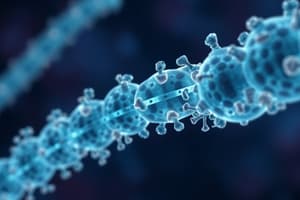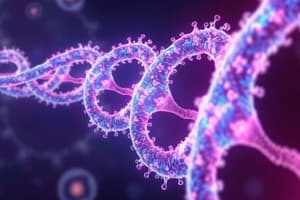Podcast
Questions and Answers
What role does APC play in relation to B-catenin?
What role does APC play in relation to B-catenin?
- APC functions independently of B-catenin.
- APC enhances B-catenin-activated gene expression.
- APC binds to B-catenin to downregulate its activity. (correct)
- APC promotes B-catenin accumulation.
Which of the following statements about chromosomal instability (CIN) in colorectal cancer (CRC) is correct?
Which of the following statements about chromosomal instability (CIN) in colorectal cancer (CRC) is correct?
- CIN results in increased functionality of APC.
- CIN contributes to a mutagenic load that is beneficial for cell survival.
- CIN is only observed in advanced stages of tumorigenesis.
- CIN is characterized by losses of discrete chromosomal regions at the earliest stages of tumorigenesis. (correct)
What is the effect of the loss of functional TGF-B signaling in colorectal cancer?
What is the effect of the loss of functional TGF-B signaling in colorectal cancer?
- It promotes activation of Wnt signaling pathways.
- It is critical for the development of CRC due to inactivation of TGF-RII. (correct)
- It enhances G1 cell cycle arrest.
- It has no effect on tumor development.
What physiological role does APC play related to the mitotic spindle?
What physiological role does APC play related to the mitotic spindle?
How does the absence of Wnt signaling affect APC's interaction with B-catenin?
How does the absence of Wnt signaling affect APC's interaction with B-catenin?
What is the primary function of Ang1 in angiogenesis?
What is the primary function of Ang1 in angiogenesis?
Which of the following describes the angiogenic switch?
Which of the following describes the angiogenic switch?
Which adhesion molecule is primarily involved in maintaining cell-cell adhesion?
Which adhesion molecule is primarily involved in maintaining cell-cell adhesion?
How do MMPs contribute to cancer metastasis?
How do MMPs contribute to cancer metastasis?
Which process describes the movement of cancer cells from a primary tumor site to distant organs?
Which process describes the movement of cancer cells from a primary tumor site to distant organs?
What role does Src play in integrin signaling?
What role does Src play in integrin signaling?
What effect do anti-angiogenic factors have in relation to tumor growth?
What effect do anti-angiogenic factors have in relation to tumor growth?
Which of the following proteins is identified to generate contractile force in cells?
Which of the following proteins is identified to generate contractile force in cells?
Which factor is known to destabilize vascular structural integrity?
Which factor is known to destabilize vascular structural integrity?
What is the primary role of TIMPs in relation to MMPs?
What is the primary role of TIMPs in relation to MMPs?
What is a key outcome of telomere shortening in human cells?
What is a key outcome of telomere shortening in human cells?
Which mechanism can oncogenes use to induce senescence?
Which mechanism can oncogenes use to induce senescence?
How do murine cells primarily bypass replicative senescence under culture stress?
How do murine cells primarily bypass replicative senescence under culture stress?
What happens when the cell cycle checkpoints p53 and RB are bypassed?
What happens when the cell cycle checkpoints p53 and RB are bypassed?
What initiates the crisis in cells with dysfunctional telomeres?
What initiates the crisis in cells with dysfunctional telomeres?
What is the role of p19ARF in relation to p53?
What is the role of p19ARF in relation to p53?
Which factor is involved in the induction of senescence through telomere dysfunction?
Which factor is involved in the induction of senescence through telomere dysfunction?
What leads cancer cells to bypass the Hayflick limit?
What leads cancer cells to bypass the Hayflick limit?
What type of mutations are observed in cells undergoing crisis due to telomere dysfunction?
What type of mutations are observed in cells undergoing crisis due to telomere dysfunction?
In the context of angiogenesis, what is the primary function of vascular endothelial cells?
In the context of angiogenesis, what is the primary function of vascular endothelial cells?
What characteristic does E-cadherin contribute to epithelial cells that is lost during epithelial/mesenchymal transition (EMT)?
What characteristic does E-cadherin contribute to epithelial cells that is lost during epithelial/mesenchymal transition (EMT)?
Which of the following accurately describes the Philadelphia chromosome (Ph) in relation to chronic myelogenous leukemia (CML)?
Which of the following accurately describes the Philadelphia chromosome (Ph) in relation to chronic myelogenous leukemia (CML)?
What is a significant effect of the BCR-ABL fusion protein in chronic myelogenous leukemia (CML)?
What is a significant effect of the BCR-ABL fusion protein in chronic myelogenous leukemia (CML)?
Why is colorectal cancer (CRC) considered one of the most common cancers in the western population?
Why is colorectal cancer (CRC) considered one of the most common cancers in the western population?
What role does the extracellular matrix (ECM) play in the metastasis of cancer cells?
What role does the extracellular matrix (ECM) play in the metastasis of cancer cells?
During which phase of chronic myelogenous leukemia (CML) is there a massive proliferation of poorly differentiated cells?
During which phase of chronic myelogenous leukemia (CML) is there a massive proliferation of poorly differentiated cells?
What is the critical flaw in mouse tumor models for studying human cancer metastasis?
What is the critical flaw in mouse tumor models for studying human cancer metastasis?
What is the primary gene associated with familial adenomatous polyposis (FAP) mutations?
What is the primary gene associated with familial adenomatous polyposis (FAP) mutations?
Which stage of chronic myelogenous leukemia (CML) is characterized by an overproduction of normal looking granulocytes?
Which stage of chronic myelogenous leukemia (CML) is characterized by an overproduction of normal looking granulocytes?
What treatment approaches are commonly used for chronic myelogenous leukemia (CML)?
What treatment approaches are commonly used for chronic myelogenous leukemia (CML)?
What are the three main functions of telomeres?
What are the three main functions of telomeres?
What is the repeat sequence found in human telomeres?
What is the repeat sequence found in human telomeres?
Which model of telomere structure is characterized by the formation of a loop?
Which model of telomere structure is characterized by the formation of a loop?
What is the main function of telomerase in relation to telomeres?
What is the main function of telomerase in relation to telomeres?
What does replicative senescence refer to in human cells?
What does replicative senescence refer to in human cells?
What happens to telomeres in normal somatic cells as they age?
What happens to telomeres in normal somatic cells as they age?
What is the Hayflick limit?
What is the Hayflick limit?
Which process contributes to altered cellular behaviors in senescent cells?
Which process contributes to altered cellular behaviors in senescent cells?
Flashcards
Telomeres: Function
Telomeres: Function
Telomeres protect chromosome ends from degradation, fusion, and ensure accurate replication.
Telomere Structure
Telomere Structure
Telomeres have a characteristic structure: a short, repeated sequence (e.g., TTAGGG in humans), and a single-stranded 3' overhang. The structure is stabilized by t-loops and G-quadruplexes.
Telomere Shortening
Telomere Shortening
Normal somatic cells shorten their telomeres with each division. Cancer cells and germ cells do not.
Telomerase
Telomerase
Signup and view all the flashcards
Replicative Senescence
Replicative Senescence
Signup and view all the flashcards
Hayflick Limit
Hayflick Limit
Signup and view all the flashcards
Telomerase's Role in Cancer
Telomerase's Role in Cancer
Signup and view all the flashcards
FISH (Fluorescent in situ hybridization)
FISH (Fluorescent in situ hybridization)
Signup and view all the flashcards
Cancer Bypassing Senescence
Cancer Bypassing Senescence
Signup and view all the flashcards
Senescence Induction
Senescence Induction
Signup and view all the flashcards
Check Points (Cell Cycle)
Check Points (Cell Cycle)
Signup and view all the flashcards
Crisis
Crisis
Signup and view all the flashcards
Angiogenesis
Angiogenesis
Signup and view all the flashcards
Lymphatic System
Lymphatic System
Signup and view all the flashcards
Blood Vessel Development
Blood Vessel Development
Signup and view all the flashcards
VEGF
VEGF
Signup and view all the flashcards
Angiopoietins
Angiopoietins
Signup and view all the flashcards
Metastasis
Metastasis
Signup and view all the flashcards
Invasiveness
Invasiveness
Signup and view all the flashcards
MMPs
MMPs
Signup and view all the flashcards
Integrins
Integrins
Signup and view all the flashcards
Cadherins
Cadherins
Signup and view all the flashcards
Extracellular matrix
Extracellular matrix
Signup and view all the flashcards
Angiogenic switch
Angiogenic switch
Signup and view all the flashcards
APC's Role in Cell Division
APC's Role in Cell Division
Signup and view all the flashcards
What happens when APC is lost?
What happens when APC is lost?
Signup and view all the flashcards
Wnt Signaling: Promoting Growth
Wnt Signaling: Promoting Growth
Signup and view all the flashcards
TGF-β Signaling: Regulating Cell Cycle
TGF-β Signaling: Regulating Cell Cycle
Signup and view all the flashcards
APC & Chromosomal Instability (CIN)
APC & Chromosomal Instability (CIN)
Signup and view all the flashcards
Metastasis: What is it?
Metastasis: What is it?
Signup and view all the flashcards
EMT: Epithelial-Mesenchymal Transition
EMT: Epithelial-Mesenchymal Transition
Signup and view all the flashcards
Why is EMT important for metastasis?
Why is EMT important for metastasis?
Signup and view all the flashcards
CML Stages: Chronic Phase
CML Stages: Chronic Phase
Signup and view all the flashcards
CML Stages: Accelerated Phase
CML Stages: Accelerated Phase
Signup and view all the flashcards
CML Stages: Blastic Phase
CML Stages: Blastic Phase
Signup and view all the flashcards
Philadelphia Chromosome: What is it?
Philadelphia Chromosome: What is it?
Signup and view all the flashcards
Philadelphia Chromosome: Importance
Philadelphia Chromosome: Importance
Signup and view all the flashcards
Gleevec: What is it?
Gleevec: What is it?
Signup and view all the flashcards
APC Gene: Role in Colorectal Cancer
APC Gene: Role in Colorectal Cancer
Signup and view all the flashcards
Study Notes
Telomeres & Cancer
- Telomeres are the ends of eukaryotic chromosomes
- They have three key functions: preventing degradation, preventing fusion with other DNA molecules, and facilitating faithful replication of the ends
- Telomere sequences are short, repeating units (e.g., TTAGGG in humans)
- They shorten with age in normal somatic cells but not in cancerous or germ cells
- Telomeres have a single-stranded 3' overhang, which is G-rich
- Telomere structure includes G-quadruplexes and T-loops
- Telomerase, an enzyme with an RNA template (TERC) and a reverse transcriptase catalytic subunit (TERT), replicates telomeres
- Telomerase activity is often activated in cancer cells; this allows for endless replication potential
- Telomere shortening can trigger replicative senescence, an irreversible cell cycle arrest.
- Senescence is characterized by changes in cellular behavior, marker gene expression, and the senescence-associated secretory phenotype (SASP)
- Cancers can bypass senescence by expressing TERT or through alternative lengthening of telomeres (ALT)
- Unprotected chromosome ends during cell division lead to chromosomal rearrangements
- This damage, telomere dysfunction, can lead to apoptosis or activate alternative mechanisms to stabilize telomeres (e.g., telomerase or ALT).
Angiogenesis
- Angiogenesis is the formation of new blood vessels from existing ones.
- Key cell types involved are vascular endothelial cells, pericytes, and smooth muscle cells.
- Angiogenesis is critical for tumor growth and treatment delivery
- VEGF is a major pro-angiogenic signaling molecule
- Angiopoietins (Ang1 and Ang2) regulate vascular integrity
- Ang1 stabilizes while Ang2 destabilizes.
- Pro-angiogenic factors (VEGF, FGF, PDGF) promote vessel growth; anti-angiogenic factors counteract this.
- The "angiogenic switch" is a critical transition in the availability of positive vs. negative factors leading to new vessel production
- Statins are examples of anti-angiogenic drugs.
Metastasis
- Metastasis is the spread of cancer cells from a primary tumor to distant sites.
- This involves invasion of surrounding tissues and movement to distal tissues.
- Key proteins related to this include integrins, cadherins, and matrix metalloproteinases (MMPs).
- Adhesion molecules, extracellular matrix (ECM), actin cytoskeleton, lamellipodia, filopodia, stress fibers, and focal contacts all contribute to cellular movement
- Rho GTPases (Rac1, RhoA, and Cdc42) play a regulatory role on cell motility.
- MMPs degrade the ECM, facilitating invasion
- TIMPs (Tissue inhibitors of MMPs) inhibit MMP activity.
- "Seed and soil" theory suggests that metastasis depends on the interaction between the cancer cell and the environment at the new site.
- EMT (epithelial-mesenchymal transition) is a cellular process that correlates with more invasive and potentially metastatic cancer cells.
- Several features affect cancer cell spread (e.g., venous drainage).
- Experimental systems study metastasis using animal models but there are inherent limitations.
Chronic Myelogenous Leukemia (CML) & Colorectal Cancer (CRC)
- CML involves uncontrolled myeloid cell production. Stages: chronic, accelerated, and blastic.
- The Philadelphia chromosome (a reciprocal translocation) creates the BCR-ABL fusion protein, a driver of the disease.
- STI-571 (Gleevec) is a potent BCR-ABL inhibitor.
- CRC is the second most common cancer.
- Colon epithelium is organized into crypts.
- Familial adenomatous polyposis (FAP) is a disorder characterized by many colorectal adenomas.
- HNPCC is associated with loss of DNA mismatch repair genes.
- APC (adenomatous polyposis coli) is a critical tumor suppressor gene involved in regulating B-catenin.
- Wnt and TGF-β signaling pathways are crucial in CRC development and progression.
Studying That Suits You
Use AI to generate personalized quizzes and flashcards to suit your learning preferences.




